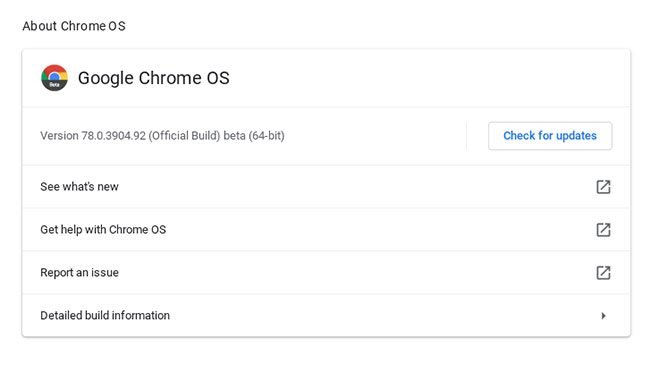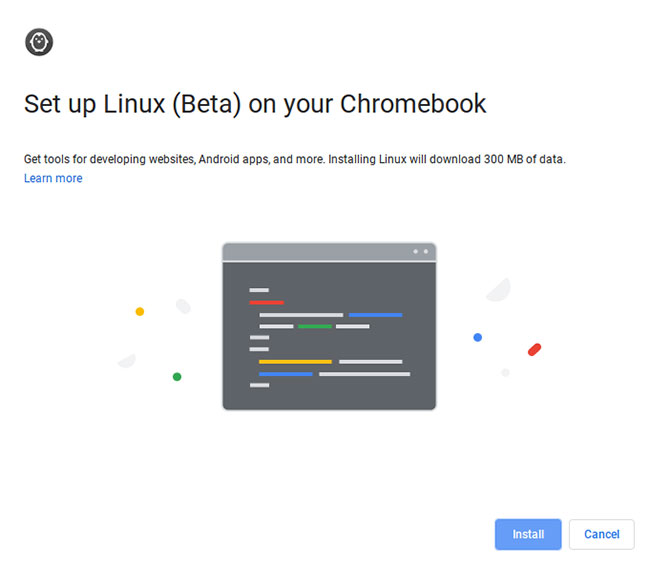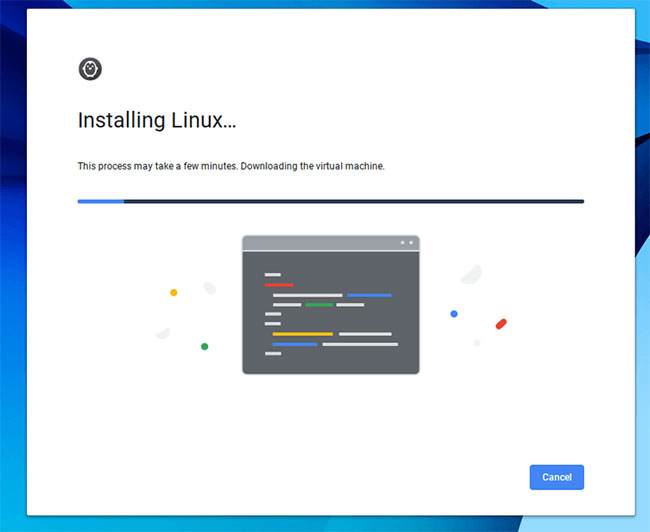How to turn on Linux App Mode on Chromebooks
What do you often think about Chromebooks? A lightweight operating system? Fast boot time? Simple browser-based interface? . Surely, when it comes to Chromebooks, many people will soon come across a word: LINUX!
Why Linux?
You might be wondering why it's Linux, because a Chromebook doesn't already do everything you want to do? If that's the case for you, great! But if you're still reading this article, you probably want your Chromebook to do more. Chromebooks are evolving their ability to use Linux. It all started to change.
Google's intention is to provide the features available to the software being developed through this platform. By activating the Linux platform (Beta), also known as Crostini , Chromebook users will now be able to install command line tools, code editors and IDEs.
Manage Chromebook settings
A Chromebook is a very simple device, but managing settings is important. To do this, very similar to managing Android devices, you have many options.
First, you can click on Clock, located at the bottom right of the taskbar.

Or you can click the Google search icon at the bottom left of the taskbar, then search for 'settings'.

Prerequisites for Linux (Beta)
Before trying to install Linux (Beta) on Chromebooks, you'll want to make sure your Chrome OS is up to date. Also, depending on the chipset, some older Chromebooks may not support Crostini.
To update Chrome OS, do the following:

1. Go to Settings.
2. Select 'About Chrome OS' .
3. Click 'Check for Updates' .
Install Linux mode (Beta)
Turning on Linux (Beta) mode on Google Chromebook is quite easy. As stated above, any major adjustments to Chromebooks will begin in the Settings window . Navigate to Settings and then select 'Linux (Beta)'.

From there, select 'Turn On'. This will launch the installation.

Click on Install.

Now sit back and wait, as this can take up to 10 minutes, depending on the resources on your Chromebook model. When the installation is completed, you will see a terminal window appear.

Once you have access to the terminal window, as with any new Linux installation, initialize your first set of update commands. To update your Linux version, enter the following command:
sudo apt update sudo apt -y upgrade You will notice that unlike Linux on the desktop, you do not need to enter a password when using the sudo command.
Alternatively, you can start installing Linux applications, such as LibreOffice, with the following command:
sudo apt install libreoffice The default distribution used is Crostini, but you can easily convert it to Ubuntu, if you want a more up-to-date application store.
In the future, there will be more and more functions that Chromebooks can perform with Linux. The possibilities are endless, from productivity applications to many tools related to network security.
Hope you are succesful.
You should read it
- Instructions for installing Linux operating system on Chromebook
- How to enable Dark Mode in Ubuntu 20.04 LTS
- 8 Best Linux Distros for Chromebooks
- How to turn on sports mode on TV to see the World Cup smooth
- How to install Linux apps on Chromebooks
- 5 ways to turn off safe mode on Android phones
- How to turn on, turn off airplane mode on Windows 10
- How to turn on Recovery Mode and Download Mode on Galaxy S9 / S9 +
May be interested
- The best Chromebook models you can buy in 2021
 recorded in the first quarter of 2021, a record number of chromebooks were sold with 12 million units shipped globally. chromebooks use google's chromeos operating system, providing a different and relatively minimalist experience that you can equip yourself this year.
recorded in the first quarter of 2021, a record number of chromebooks were sold with 12 million units shipped globally. chromebooks use google's chromeos operating system, providing a different and relatively minimalist experience that you can equip yourself this year. - How to turn on dark mode for Slack on iPhone and Android
 slack offers dark mode integrated on iphone, ipad and android. this article will show you how to enable this mode with a few simple steps and use a darker interface.
slack offers dark mode integrated on iphone, ipad and android. this article will show you how to enable this mode with a few simple steps and use a darker interface. - How to turn on Dark Mode Messenger
 how to turn on dark mode messenger dark mode has many advantages such as: saving battery, reducing eye strain, displaying clear content, ... in this article, software tips will guide you how to turn on dark mode on messenger.
how to turn on dark mode messenger dark mode has many advantages such as: saving battery, reducing eye strain, displaying clear content, ... in this article, software tips will guide you how to turn on dark mode on messenger. - How to turn on Dark Mode on Google Keep and Google Calendar
 dark mode is becoming more and more popular. dark themes make the eyes more pleasant and they look great. in addition, using the dark mode for the application can improve the battery life of the phone or tablet.
dark mode is becoming more and more popular. dark themes make the eyes more pleasant and they look great. in addition, using the dark mode for the application can improve the battery life of the phone or tablet. - How to turn any Linux PC into HTPC without Kodibuntu
 kodi is an excellent open source home theater system and, thanks to its wide availability, is the leading diy media center software.
kodi is an excellent open source home theater system and, thanks to its wide availability, is the leading diy media center software. - How to turn on Safe Mode on Android
 if in the process of use, users discover that your device running android (smartphone or tablet) is frequently stalled, sluggish or battery problems cause the battery to run out quickly ... users can access go to safe mode to check if the above problems still happen?
if in the process of use, users discover that your device running android (smartphone or tablet) is frequently stalled, sluggish or battery problems cause the battery to run out quickly ... users can access go to safe mode to check if the above problems still happen? - How to turn off restricted mode on YouTube
 turning on restricted youtube video mode also affects the video source somewhat and hides video comments that you can access, while we already have youtube kids videos specifically for kids.
turning on restricted youtube video mode also affects the video source somewhat and hides video comments that you can access, while we already have youtube kids videos specifically for kids. - How to turn on Kiosk Mode on Android devices
 activating kiosk mode on android phones or tablets allows you to lock your device with apps listed in whitelist (whitelist) or a single browser window.
activating kiosk mode on android phones or tablets allows you to lock your device with apps listed in whitelist (whitelist) or a single browser window. - How to enable Developer Mode on Chromebook
 developer mode on chromebooks allows you to perform a series of advanced tasks.
developer mode on chromebooks allows you to perform a series of advanced tasks. - How to turn on Dark Mode on YouTube
 how to turn on dark mode on youtube. on youtube this day also supports dark mode to prevent users from eye strain when watching for too long. in this article, software tips will guide you how to turn on dark mode on youtube.
how to turn on dark mode on youtube. on youtube this day also supports dark mode to prevent users from eye strain when watching for too long. in this article, software tips will guide you how to turn on dark mode on youtube.










 How to save battery on PS4 gaming controllers
How to save battery on PS4 gaming controllers Best HDMI cable for monitors, LG TVs, Samsung and Apple TVs
Best HDMI cable for monitors, LG TVs, Samsung and Apple TVs 7 best PS4 gaming controllers
7 best PS4 gaming controllers Review Google Nest Wifi: Mesh router is smarter
Review Google Nest Wifi: Mesh router is smarter Instructions on how to adjust and match the subwoofer into a 2-channel amplifier at home
Instructions on how to adjust and match the subwoofer into a 2-channel amplifier at home